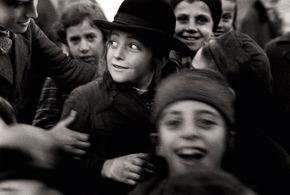Roman Vishniac Rediscovered September 24, 2015–January 3, 2016

Roman Vishniac, [Jewish schoolchildren, Mukacevo], c. 1935–38, gelatin silver print. © Mara Vishniac Kohn, courtesy International Center of Photography
Roman Vishniac, [Sara, sitting in bed in a basement dwelling, with stenciled flowers above her head, Warsaw], c. 1935–37, platinum print. © Mara Vishniac Kohn, courtesy International Center of Photography
Roman Vishniac, [Interior of the Anhalter Bahnhof railway terminus, near Potsdamer Platz, Berlin], 1929–early 1930s, inkjet print. © Mara Vishniac Kohn, courtesy International Center of Photography
Roman Vishniac, [Boy standing on a mountain of rubble, Berlin], 1947, inkjet print. © Mara Vishniac Kohn, courtesy International Center of Photography
Roman Vishniac, [Vishniac’s daughter Mara posing in front of an election poster for Hindenburg and Hitler that reads “The Marshal and the Corporal: Fight with Us for Peace and Equal Rights,” Wilmersdorf, Berlin], 1933, gelatin silver print. © Mara Vishniac Kohn, courtesy International Center of Photography
Roman Vishniac, Cross section of a pine needle, early 1950s–late 1970s, digital file from color transparency. © Mara Vishniac Kohn, courtesy International Center of Photography
Roman Vishniac, [Preparing food in a Jewish soup kitchen, Berlin], mid- to late 1930s, gelatin silver print. © Mara Vishniac Kohn, courtesy International Center of Photography
Roman Vishniac, [Drawer of freshly farmed eggs, Gut Winkel, a training farm for German Jewish youth hoping to immigrate to Palestine, Spreenhagen in der Mark, Brandenburg, Germany], c. 1938, inkjet print. © Mara Vishniac Kohn, courtesy International Center of Photography
More than any other photographer, Roman Vishniac profoundly influenced contemporary impressions of Jewish life in Eastern Europe. Vishniac created the most widely recognized and reproduced photographic record of that world on the eve of its annihilation, yet very little of his work was published or printed during his lifetime (1897–1990).
Roman Vishniac Rediscovered provides an introduction to Vishniac's radically diverse body of work—much of it only recently discovered. Known primarily for his poignant images of Eastern Europe, Vishniac was in fact a remarkably versatile and innovative photographer. This exhibition repositions his iconic photographs of Eastern Europe within a broader tradition of social documentary photography. Vishniac's career spans more than five decades, ranging from early engagements with European Modernism to highly inventive color photomicroscopy.
As an amateur photographer in Berlin in the early 1920s, the Russian-born Vishniac took to the streets, offering intelligent and wry visual commentary while experimenting with new approaches to framing and composition. He documented the Nazi rise to power and photographed impoverished Jewish communities in Eastern Europe.
After fleeing to New York in 1941, he opened a portrait studio, recorded American Jewish communal and immigrant life, and established himself as a pioneer in photomicroscopy (taking photographs with a microscope). In 1947, Vishniac returned to Europe to document Jewish displaced-persons camps, the ruins of Berlin, and efforts of Holocaust survivors to rebuild their lives. Vishniac's work in color photomicroscopy was his primary focus for the remainder of his life.
“Roman Vishniac Rediscovered" is organized by the International Center of Photography: Maya Benton, curator. It is made possible with support from the National Endowment for the Arts.
In New York, the exhibition was made possible with support from Mara Vishniac Kohn, whose generosity founded the Roman Vishniac Archive at ICP, and by the Andrew and Marina Lewin Family Foundation, Estanne and Martin Fawer, the David Berg Foundation, the Righteous Persons Foundation, the National Endowment for the Arts, the Olitsky Family Foundation, the Conference on Jewish Material Claims Against Germany, and numerous additional donors.

Generous funding is provided by:
The David Berg Foundation
Barbara and Gerry Hines
Shirley Toomim
Cyvia and Melvyn Wolff
Additional generous funding is provided by Bruce Stein Family/Triple S Steel; Rolaine and Morrie Abramson; Joan and Stanford Alexander; Nancy Beren and Larry Jefferson; Jerry and Nanette Finger Family; Barbara and Michael Gamson; Joyce Z. Greenberg; Barbara and Charles Hurwitz; Joan and Marvin Kaplan; Ann and Stephen Kaufman; Helaine and David Lane; Susan and Jack Lapin; Rochelle and Max Levit; Mrs. Joan Schnitzer Levy; Barbara and Barry Lewis; Suzanne Miller; Ms. Joan Morgenstern; Paula and Irving Pozmantier; Herman Proler; Minnette Robinson; Leslie and Russ Robinson; Regina Rogers in honor of Stefi Altman; The Lester and Sue Smith Foundation; Sugar Land Skeeters; Mr. and Mrs. Conrad Weil, Jr.; Erla and Harry Zuber; and additional supporters of the exhibition.
